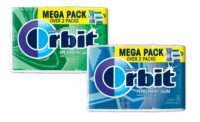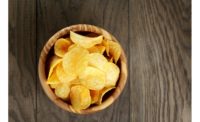On the Rebound
by Dan Malovany
Remember when consumers fell for a craze called Atkins that seduced a nation of unsuspecting dieters, by promising that the pounds would just melt off as they boned up on the protein and cut the carbs?
Yes, Americans could eat their porterhouse steaks or even two, but couldn’t touch even one slice of bread when on the weight-loss portion of the diet. If they did, everything would be ruined and they’d have to start all over again.
Doesn’t that seem silly in hindsight?
What a difference a year or so makes! Although Americans remain conscious of their carbs, whole grains have become the hot button during the last 12 months, and the media hype over grains has only intensified the trend.
First, in January, the baking industry received a slew of positive publicity after the U.S. departments of Agriculture and Health and Human Services revealed the 2005 Dietary Guidelines, which urged Americans to eat more grains.
| THE TOP 10 VENDORS Fresh Bread (For 52 weeks ending Feb. 27, 2005) | ||||||
| Rank | Brand | Dollar Volume (in millions) | % Change | Dollar Share | Unit Sales (in millions) | % Change |
| 1 | Interstate Brands Corp. | $784.6 | -2.0% | 13.8 | 386.8 | -4.8% |
| 2 | George Weston, Inc. | $620.2 | +6.3% | 10.9 | 291.4 | -4.1% |
| 3 | Sara Lee Bakery Group | $579.6 | +0.2% | 10.2 | 262.4 | -3.5% |
| 4 | Bimbo Bakeries U.S.A. | $407.1 | +3.1% | 7.1 | 163.3 | +0.2% |
| 5 | Pepperidge Farm | $319.2 | +7.4% | 5.6 | 118.2 | +3.1% |
| 5 | Flowers Bakeries | $315.7 | +2.7% | 5.5 | 164.6 | -1.7% |
| 5 | Quality Baker of Amer. Coop. | $103.9 | -5.8% | 1.8 | 65.3 | -6.7% |
| 5 | Perfection Bakers, Inc. | $70.2 | +1.4% | 1.2 | 39.9 | -0.6% |
| 5 | General Mills | $64.8 | -10.0% | 1.1 | 29.6 | -9.5% |
| 10 | Lewis Bakeries | $63.4 | -4.6% | 1.1 | 35.4 | -6.3% |
| TOTAL* | $5,705.0 | +0.3% | 100.0 | 3,318.9 | -3.6% | |
| *including brands not shown Source: Information Resources Inc., Supermarkets only | ||||||
Then in February, the Grain Foods Foundation launched its much-awaited promotion declaring that “Bread. It’s Essential.” The campaign generated more than 1,000 media reports, appearing on such networks as ABC, CBS, NBC, CNN and Fox news, and in local newspapers across America’s heartland. Unlike before, when most reports were neutral or negative, more than two-thirds of them were positive, stressing the role that grain-based foods can play in a healthy, balanced lifestyle.
With a heightened consciousness as a result of such media reports, it seems that consumers are taking another look at the bread aisle.
Indeed, the bread aisle has been evolving slowly but surely throughout the last 20 years, as bakers have added more variety breads to the shelf. However, during the last 10 months, the pace of change has been accelerating, with new variety breads and multigrain offerings hitting the shelf each month, and resulting in significant changes in the way bread is bought and sold, says Jay Gould, Pepperidge Farm’s president.
“We’re seeing the competitive dynamics move from price promotion to consumer-led innovation, and I see that as a good move for everyone in the value chain — for the consumers, the customers and, ultimately, the producers,” he explains. “It’s good for customers because they need to make more money in the bread aisle, and you don’t do that running a [buy-one-get-one] every week. If we move to a rational pricing environment, it gives us the opportunity to really invest against the consumer.”
Now, Anything Goes
Five years ago, the bulk of multigrain and variety breads were pretty similar — 7-Grain with Honey, Whole Wheat 9-Grain with Honey, Stone Ground Wheat, 100% Whole Wheat and Hearty 12-Grain, to name a few — but now, anything goes.
Today, sliced variety breads contain bulgur, flaxseed, almonds, walnuts, soybean, sunflower seeds, barley, buckwheat, millet and corn grits, among other ingredients. Bakers are adding Omega-3 oils, calcium, Vitamin D, folic acid, triticale, fiber, extra fiber and even more extra fiber. They’re even using canola oils and olive oil instead of hydrogenated oils.
In some cases, varieties are simply “out of the box.” Take a Chipotle Bread to be released later this spring by Flowers Foods Bakery Group, for example. It’s one of four, out-of-the-ordinary varieties of whole-grain, sliced sandwich breads under the Cobblestone Mill brand.
“It has a little bite to it. It doesn’t set you on fire, but it definitely has a chipotle pepper bite to it,” explains Janice Anderson, vice president of marketing for Flowers.
Other varieties include Sourdough Dill, Wheat ’n Flax, which contains Omega-3 fatty acids, and Savory Mediterranean, which is made with olive oil and herbs.
“Because we know there are going to be a lot of whole-grain offerings in the market — and very good offerings, by the way — we were looking for something that’s outside of the pack and was truly unique and different, and we think we’re there,” Anderson says.
In April, the Thomasville, Ga.-based bakery rolled out cranberry raisin, maple French toast and cinnamon-flavored breakfast breads under its flagship Nature’s Own brand.
The new Nature’s Own Special Mornings breakfast breads are distinctively different from what had been in the bread aisle, in that they’re one of the first whole-grain offerings in this segment. At the same time, they don’t have the dense, muffin-like texture of many conventional breakfast breads. They can be toasted in the morning or eaten right out of the bag as a snack anytime.
“Our Nature’s Own bread has always been positioned as a soft variety bread, and softness makes these breads different from typical breakfast breads that have a tighter grain and a more compact loaf,” Anderson notes. “These are standard, 20-oz. loaves of bread, but they are soft like the rest of the Nature’s Own variety line.”
Today, Nature’s Own is a $400 million brand at retail, making it the No. 1-selling soft variety bread in the nation, while Cobblestone Mill is approaching the $100 million mark.
Multiples of Multigrain
New variety breads seen to be sprouting up everywhere. For instance, Franz Family Bakeries, also known as United States Bakeries, continues to go all-natural, in more ways than one. During the past three years, the Portland, Ore.-based company has rolled out natural products named after famous national landmarks in the greater Northwest, such as Redwood Forest Flax & Grain, Mount Hood Winter Wheat or Columbia River Sweet Dark Whole Grain. By doing so, Franz is smartly leveraging its natural breads against some of the area’s most renowned natural landmarks.
The latest is Crater Lake All Natural Whole Grain Oatnut bread, with 100% whole wheat and nuts. “Inspired by the purity of Crater Lake,” the glamour copy reads, the product contains a blend of whole grain, oats and nuts and contains no artificial flavors, colors, preservatives or trans fat. It also doesn’t contain high-fructose corn syrup (HFCS), which is found in many sweetened beverages and cited by many consumer advocates as a major contributor to the child obesity epidemic.
Franz also introduced 100% whole-wheat hamburger and hot dog buns. It has even gone bilingual with the Franz White-Pan Blanco with no trans fat or cholesterol and a low number of total fat.
Meanwhile, Sara Lee Bakery Group has been riding the healthy-bread trend in a major way by introducing whole-grain breads fortified with folic acid, calcium and Vitamin D. The six new breads, rolled out under the Heart Healthy Plus platform are the latest additions to the Sara Lee line, which in two years has become a $125 million brand.
Additionally, the St. Louis-based bakery group relaunched its Earth Grains line with three “extra fiber” varieties that have 35% of the government’s Recommended Daily Value (RDV) for fiber.
The brand’s nine varieties all have 20% of the RDV for folic acid, 30% of the RDV for calcium and 20% of the RDV for Vitamin D.
Also on the fiber front, Fort Wayne, Ind.-based Perfection offers some varieties of Aunt Millie’s Hearth Fiber for Life breads that have as much fiber per serving as many high-fiber cereals.
For the southern and western markets it serves, Bimbo Bakeries USA (BBU) expanded its variety bread offerings with Oroweat Whole Grain Nut bread, made with almonds. It joins a portfolio with Honey Whole Wheat and Amber Grains. The breads have the appearance, taste and texture of white bread with all of the benefits of whole grain and fiber.
In April, the Fort Worth, Texas-based company also introduced Health Essentials sugar-free hamburger and hot dog buns under the Mrs Baird’s brand, for both diabetics and families searching for a healthier alternative, says Dan Larson, marketing director.
Additionally in the health arena, Bimbo and George Weston Bakeries, from which BBU bought Oroweat and other assets west of the Mississippi a few years ago, have acquired the license for Weight Watchers breads. Both companies also license low-carb breads carrying the Atkins Diet symbol.
Even late bloomers to the superpremium-bread segment are ratcheting up their offerings. Interstate Bakeries Corp. recently rolled out four more varieties of Baker’s Inn bread, according to Bob Morgan, executive vice president of sales and trade marketing.
Nine Grain, Stone Ground Whole Wheat with Extra Fiber, Crunchy Honey Oat, and Cinnamon Wheat join the initial offerings of 100% Whole Wheat, Honey Whole Wheat, Harvest MultiGrain, Raisin Wheat, Seven Grain, Honey White, and Hearty Potato with Grain to give consumers 11 wholesome choices to chew on.
Baker’s Inn was named a Top 10 “brand to watch” by Information Resources, Inc., in its 2005 “New Product Pacesetters” report. To qualify as a pacesetter, brands must achieve a certain sales threshold in food, drug and mass channels (excluding Wal-Mart) in their first year. Less than one quarter of new brands or brand extensions introduced in 2003-2004 reached that threshold, according to IRI.
Good Times or Bad?
Some bakeries with a large exposure to white bread, especially private-label white bread, such as Interstate Bakeries Corp., are experiencing tough times. The Kansas City, Mo.-based company, which is in Chapter 11 reorganization, continues to lose money — partly because of its product mix, but also because of a host of other issues such as rising overhead, pension issues and skyrocketing health benefits.
For variety-bread bakers like Pepperidge Farm, the story is just the opposite. In fact, its total business for products in the bread aisle is up 12% for the first nine months of fiscal 2005 ending April 30.
“This is a fantastic year for us,” Gould says. “Our breakfast business is up dramatically, in part because of bagels and English muffins, which combined are approaching 50% growth. One key driver has been a significant push toward whole grain.
The dramatic growth also has been fueled by market penetration, repeat sales, geographic expansion into new territories and an aggressive promotion campaign that has targeted the breakfast eating occasion, Gould explains.
Moreover, Pepperidge Farm has benefited from trading up to more premium variety breads, such as its Farmhouse and Natural Whole Grain lines. Despite the waning of the carb craze and the company’s lateness to market with a low-carb option, its Carb Style breads and rolls continue to grow as the entire healthy-eating trend remains strong. Look for Pepperidge Farm to strengthen its product portfolio in the near future, when it repositions its whole-grain bread line to include eight varieties, four of which are new.
“When we have a consumer insight, we like to drive it across our entire portfolio. You will be seeing a whole-grain emphasis across the range of Pepperidge Farm products,” Gould says. “One other example would be Whole Grain Texas Toast. We’re bringing whole grain into the freezer case.”
Moreover, throughout the Midwest, “business is booming” for Alpha Baking, says Larry Marcucci, president.
Since January, the Chicago-based company has been racing to keep up with expanding demand from its current customers, who are trying to expand their market share, and from new business that has come its way in both the retail and foodservice channels.
“Normally, in the beginning of the year, we like to have 10 irons in the fire, so that you can get two or three of them to go, and now it seems like nine of them went our way,” Marcucci says.
Part of the business involved a little luck. The $150 million company picked up about 160 quick-serve restaurants (QSRs) after one of the struggling major players in the industry exited the business.
However, a little strategic planning is paying off big-time.
“We put on some salespeople [during] the depths of the darkness, figuring Atkins can’t live forever, and sure enough, he didn’t and it didn’t,” Marcucci explains. “It gave us some time to get things going and get out and meet customers. To a certain degree, there have been opportunities for companies to take pricing in our business recently. Quite often, that causes customers to look around. If you have people on the street working the business, at least you get the shot. A lot of people came out of Atkins and said, ‘We need to find some new items.’”
On the retail front, Alpha Baking is developing two new multigrain rolls for a major customer. Another alternate-format retailer has picked up its organic bread line. It’s also rolling out a new multigrain roll for a major mass-merchandiser under its S. Rosen’s label and larger packages of its products for a wholesale club that it serves.
Creating Signature Breads
In the foodservice arena, the low-carb craze dented consumers’ enthusiasm for gourmet bread sandwiches last year. However, Panera Bread has seen its sales rekindle some of its fire during the past few months. In fact, sales for Panera bakery/cafes open for at least 18 months rose 6.6% for the 12 weeks ended March 22, 2005.
In the foodservice market, restaurants, sub shops and fast-food chains are following Panera’s lead and are refreshing their menus with upscale breads that command a higher price point. Chains such as Blimpie International that didn’t upgrade have seen their business go elsewhere.
Recently, Chick-fil-A started serving chicken sandwiches on wheat buns. Wendy’s is testing sandwiches made on bread called Frescata, which has a crisp crust, soft interior and is baked in the restaurants.
Einstein Brothers has diversified from bagels to selling paninis using grilled ciabatta bread. Likewise, Jack-in-the-Box began serving its chicken sandwiches on thick-crusted ciabatta bread. Even the struggling Blimpie International finally got on the bandwagon and recently began offering ciabatta in an effort to spruce up the images of its traditional subs.
However, despite all of the steps that the bread industry has taken in the healthy eating arena, more needs to be done, according to Virgil Smail, head of the grain science and industry department at Kansas State University.
Smail believes that bakers need to take a quantum leap and begin to develop a new generation of breads and rolls that are formulated to actually combat obesity and offer multiple health benefits while still tasting good.
“‘Balance with exercise and a healthy diet’ is a good message, but the reality is that most people aren’t willing or don’t know how to do that,” Smail explains. “The opportunities for the food industry in the future are going to be to offer consumers products to help them with their diets, help them lose weight by offering satiety; help with heart health by offering appropriate fatty acids and antioxidants; help prevent cancer by offering phytonutrients and bran; fight osteoporosis with calcium supplement and so on.
“These claims are appearing in products one claim at a time, but consumers tend to want all of these claims in one package,” he adds. “We do not want to have to have toast in the morning for bran, a sandwich at lunch for calcium and dinner rolls at night for phytonutrients.”
The Best Thing Since Sliced Bread
By Maria Pilar Clark
What do consumers think about bread? The Grain Foods Foundation (GFF) has launched a multi-million-dollar public-education campaign to find out, and the results are the toast of the town.
According to a recent survey of more than 2,000 American adult consumers conducted by Harris Interactive, 50% of those surveyed declared they “love eating bread,” and 50% claimed that they “eat bread almost every day.” A surprising 12% asserted that they “are aware that bread consumption can aid in the fight against serious health conditions.” In addition, 24% of those surveyed agree that following an eating plan restricting carbs is a sensible dietary approach.
Additional findings discovered that nearly one of five (19%) women ages 35 to 44 perceive bread to be unhealthy and/or fattening. And only one of 10 (9%) women believe that bread is important for keeping bad health at bay.
Moreover, the survey unearthed that the passion for bread consumption appears to decrease with age. Of those surveyed who were 18 to 34 years old, 64% (70% of women in that range) indicated that their love affair with bread consumption was still going strong, while only 39% of people ages 55 and older shared the same devotion to bread.
Not only can bread contribute to the prevention of heart disease, some cancers and other maladies, but it also can foster a healthy immune-system environment in the human body. The GFF and health-and-wellness movement go hand in hand. Bread is back, and the foundation is on a roll — promulgating their “Bread is Essential” message to consumers.



